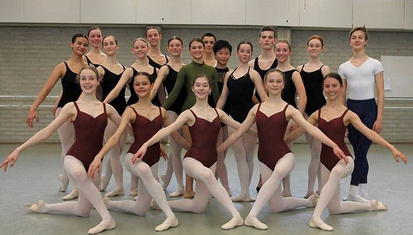On Friday 13 March, the day we had to stop giving classes due to the corona measures, we were fortunate to receive some good news as well. To our great delight, we got permission from the Accreditation Organisation of the Netherlands and Flanders (NVAO) for a new form of education within the NBA: the two-year Associate Degree in Classical Ballet. Starting in the coming academic year, it will be possible for NBA students to take this relatively new course within professional education – co-existing with Bachelor’s and Master’s degrees – and to complete it in two years with an Associate Degree certificate at higher professional education level.
The official report by the NVAO – the organisation that decides whether a new course can be introduced – still has to be published, but the organisation informed us on 13 March that their assessment of our new Associate Degree (AD) course was positive.
Starting in the new academic year, it will be possible for higher professional education students at the Dutch National Ballet Academy to follow the two-year AD programme. They will then be ready to enter the field as professional dancers. Following the two-year course, it is also possible for students to add on a third year, to attain a Bachelor’s degree (BA) at higher professional education level, allowing them to specialise in a particular aspect of theory or teaching within classical ballet. Students are ready to enter the professional field after this third year, as well. However, the BA year is also open to students who first attain their AD, then start their dancing career and on ending that career wish to specialise in a particular area of interest and obtain a BA degree. This allows the Dutch National Ballet Academy to provide a lifelong learning option within ballet education. In the coming period, we will be working on the exact content of this BA year.
Why make this change?
For some time now, the Dutch National Ballet Academy has been looking for a form of education that is in line with current professional practice. The present form of education we have been offering in recent years takes a relatively long time – a seven-year preliminary course (linked to primary and secondary education), followed by a three-year BA course. This means that our students now train for ten years before being able to start as a professional dancer. Similar training courses abroad often take less time, meaning that international dancers can enter the professional field earlier. In addition, more and more junior companies are springing up, in the Netherlands and abroad, offering talented young dancers a safe learning and working environment and thus enabling them to move up sooner to the professional field.
So the introduction of the AD means that our students can make the switch to the professional field one year earlier. An additional advantage is that the AD is not bound to ‘sector agreements’. At the moment, we can only admit nine new students a year to the BA, which is barely enough to form a class, let alone separate classes for boys and girls. An efficiency survey was conducted for the AD, which tested whether there was sufficient demand from students for this course and whether the professional field can offer work to a larger number of graduates. The answer to both questions in the survey was positive. We can admit 24 students a year to the AD programme (ideally fifty percent boys and fifty percent girls), meaning that we can provide better education to classes with sufficient volume for specialised lessons.
What does this mean in concrete terms?
The two-year AD programme focuses on technical and skilled knowledge of ballet (classical, pointework, male technique, variations, repertoire and work experience with Dutch National Ballet). In addition, the familiar theoretical subjects will still be given and attention will be paid to strength training, Pilates and body conditioning. So the programme looks similar to our current year 1 and 2 Bachelor’s programme, but the competencies taught have been adjusted here and there, and are now better attuned to the professional field of the classical ballet dancer. The current third year, the apprenticeship year, will be discontinued. The practical experience gained by students in the productions by Dutch National Ballet, however, will certainly remain part of our AD programme.


